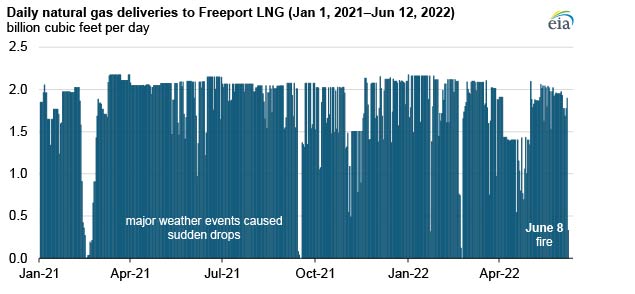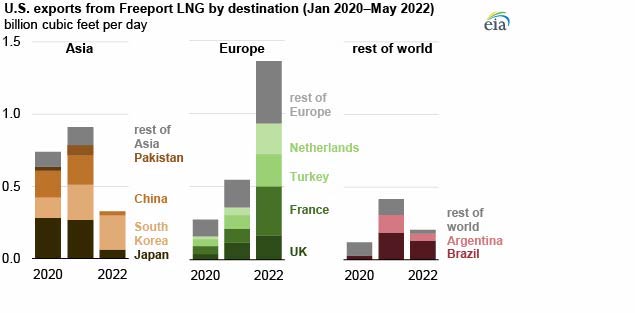
On June 8, 2022, a fire at Freeport LNG‘s natural gas liquefaction plant on the Gulf Coast in South Texas led to the full shutdown of the facility. The shutdown of Freeport LNG will reduce total U.S. liquefied natural gas (LNG) export capacity by approximately 2 billion cubic feet per day (Bcf/d), or 17% of total U.S. LNG export capacity.
Freeport LNG is one of seven LNG export facilities operating in the United States. Freeport LNG has three operating liquefaction units (called trains) that have a combined baseload capacity of 1.98 Bcf/d and peak capacity of 2.14 Bcf/d. The facility shipped its first LNG cargo in September 2019, and it was the fifth U.S. LNG export terminal to come online in the Lower 48 states. A fourth liquefaction train (with a capacity of 0.67 Bcf/d) has been fully approved, but its owner has not yet reached a final investment decision.
According to Freeport LNG Development, L.P., the preliminary assessment suggests that the fire was caused by excess pressure in an LNG transfer pipeline that moves LNG from the facility’s storage tank to the terminal’s dock facilities. The fire did not affect Freeport LNG’s main facilities, such as its liquefaction trains, LNG storage tanks, dock facilities, or LNG process areas. The company announced that it does not expect the terminal to return to full service until late 2022, although it aims to have the terminal partially operating in approximately 90 days.
Outages at Freeport LNG have occurred in the past but were either short lived or limited in scope. For example, during February 2021, all three trains were eventually shut down following a freezing weather event that caused blackouts across the state. The plant operated at reduced capacity over a 14-day period from February 12 through February 25, and all three trains were briefly shut down for 2 days, from February 16 through February 17. In June 2021, two unplanned intraday outages occurred within one week. Each was due to a compressor malfunction that affected a single train, and each briefly reduced overall production capacity. In addition, from September 14, 2021, through September 17, 2021, all three trains were shut down due to a power outage following Tropical Storm Nicholas.

Feedgas (natural gas delivered by pipeline to an LNG liquefaction facility) flowing to Freeport LNG averaged 1.77 Bcf/d from January to May 2022, and it averaged 1.83 Bcf/d during the seven days before the fire, according to analysis of data from PointLogic. Similar to other U.S. LNG export facilities, Freeport LNG has been operating at high utilization rates this year. During January–May 2022, Freeport LNG’s utilization averaged 92% of peak capacity, compared with 86% of peak capacity during the same period last year and 87% of peak capacity in 2021, according to EIA estimates.
Exports from the Freeport LNG terminal averaged 1.9 Bcf/d from January to May 2022, compared with 1.8 Bcf/d during the same period last year and an annual average of 1.9 Bcf/d in 2021. In a shift from historical trends in LNG export destinations, and similar to other U.S. LNG export facilities, almost three-quarters (72%) of exports from Freeport LNG were shipped to Europe (including Turkey) during the first five months of this year, compared with 29% on average during 2021. During January–May 2022, LNG exports from Freeport LNG to Asia declined by 64% compared with 2021 and averaged 0.3 Bcf/d (17% of the total exports).




Follow us on social media: